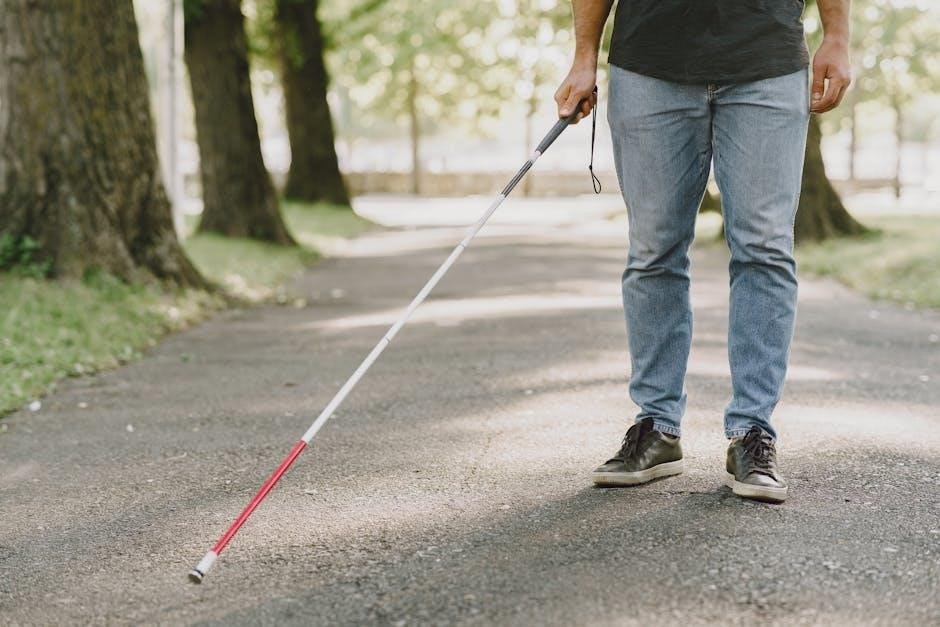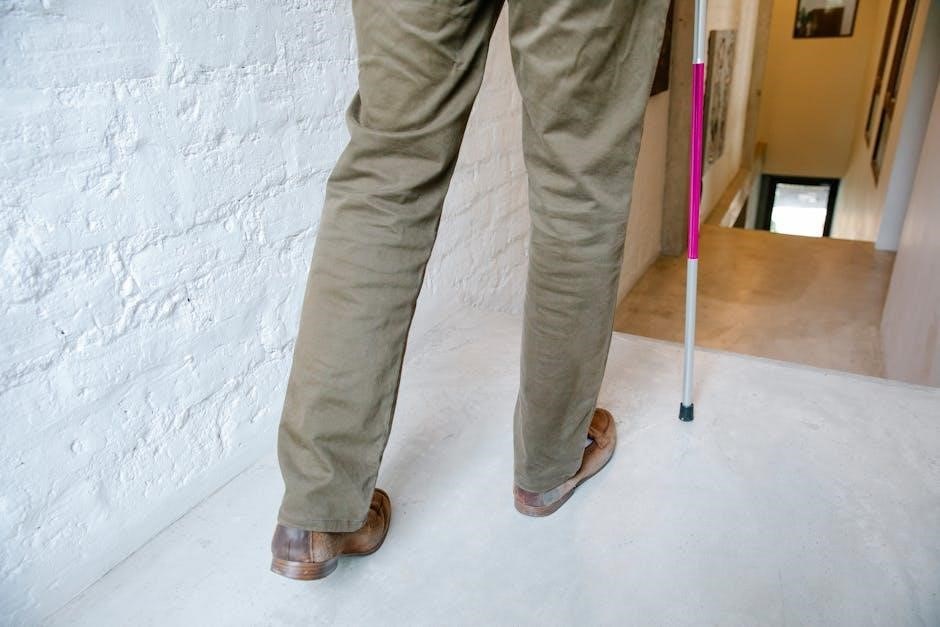Guide canes are mobility devices designed to enhance the independence and safety of individuals with visual impairments․ These canes serve as a crucial tool, allowing users to navigate their environment with greater confidence and avoid potential obstacles, promoting a more active lifestyle․

What is a Guide Cane?

A guide cane, often referred to as a white cane, is a mobility aid primarily used by individuals who are blind or visually impaired․ It’s more than just a stick; it’s an extension of the user’s senses, providing tactile information about the surrounding environment․ The cane helps detect obstacles, changes in elevation, and other potential hazards that might not be apparent to someone with limited or no vision․
The guide cane acts as a buffer, allowing the user to probe the path ahead before fully committing to a step․ This provides crucial time to react and avoid collisions or falls․ Furthermore, the white color of the cane serves as a universal symbol, alerting others to the user’s visual impairment and encouraging them to offer assistance or be more mindful of their presence․
Essentially, the guide cane is a tool that promotes independence, safety, and confidence, allowing visually impaired individuals to navigate the world with greater ease and autonomy․
Purpose and Benefits of Using a Guide Cane
The primary purpose of a guide cane is to enhance the mobility and safety of individuals with visual impairments․ By providing tactile feedback about the environment, the cane allows users to detect obstacles, changes in terrain, and drop-offs, enabling them to navigate independently and confidently․
The benefits extend beyond simple obstacle detection․ Using a guide cane fosters independence, allowing individuals to participate more fully in daily activities and reducing reliance on others․ It improves spatial awareness, helping users develop a mental map of their surroundings and navigate familiar routes more efficiently․ The cane also serves as a visual cue to sighted individuals, alerting them to the user’s visual impairment and encouraging them to be more considerate․
Furthermore, the act of using a guide cane promotes physical activity and can contribute to improved balance and coordination․ It empowers individuals to maintain an active lifestyle, reducing feelings of isolation and promoting overall well-being․ Ultimately, the guide cane is a tool that enhances independence, safety, and quality of life for visually impaired individuals․

Types of Guide Canes
Guide canes come in various forms, each designed to suit different needs and preferences․ These include the long cane, the folding cane for portability, and the smart cane, which uses technology to enhance navigation and safety for the user․

Long Cane
The long cane is the most traditional and widely recognized type of guide cane․ It extends to approximately the sternum of the user, offering a wide sweep to detect obstacles in their path․ Constructed from lightweight materials like aluminum or fiberglass, the long cane provides tactile feedback, allowing the user to gather information about the terrain ahead․ Its primary function is obstacle detection, providing the user with advanced warning of steps, curbs, or other potential hazards․
The length of the cane is crucial for effective use, and it is typically determined by a trained orientation and mobility specialist․ Proper technique involves sweeping the cane from side to side, maintaining consistent contact with the ground․ This sweeping motion creates a protective zone, enabling the user to navigate safely and confidently․ The long cane is a simple yet highly effective tool, empowering individuals with visual impairments to maintain their independence and navigate the world around them․
The long cane is a reliable and time-tested mobility aid, providing essential tactile information for safe navigation․
Folding Cane
The folding cane offers a significant advantage in portability and convenience compared to the traditional long cane․ As the name suggests, this type of cane can be easily folded into multiple sections, making it compact and easy to store in a bag, purse, or even a pocket when not in use․ This feature is particularly beneficial for individuals who may not require the cane at all times or who frequently transition between different environments․

Folding canes are typically constructed from lightweight yet durable materials such as aluminum, ensuring both ease of use and longevity․ They are designed with joints that allow the cane to be quickly and easily assembled and disassembled․ While offering similar obstacle detection capabilities as the long cane, the folding cane prioritizes convenience and portability․ This makes it an excellent choice for users who value flexibility and ease of transport in their mobility aid․
Despite its collapsibility, a well-designed folding cane maintains sufficient rigidity and tactile feedback to provide reliable navigation assistance․ The folding cane represents a practical and adaptable solution for individuals with visual impairments․
Smart Cane (Electronic Travel Aid)
Smart canes, also known as electronic travel aids (ETAs), represent a significant advancement in mobility assistance for individuals with visual impairments․ These innovative devices integrate electronic sensors, microprocessors, and other technologies to provide enhanced environmental awareness beyond the capabilities of traditional canes․ Smart canes utilize a variety of sensors, such as ultrasonic sensors and infrared sensors, to detect obstacles at a greater range and provide information about their distance and location․
The information gathered by these sensors is then processed by an onboard computer, which alerts the user to potential hazards through auditory, tactile, or vibratory feedback․ Some smart canes also incorporate GPS navigation systems, allowing users to plan routes and receive real-time directions․ Furthermore, certain models offer voice assistance integration, enabling users to access information, make calls, and control other smart devices hands-free․
While smart canes offer numerous advantages, they also come with considerations such as battery life, cost, and the learning curve associated with mastering their advanced features․ However, the potential for increased independence and safety makes them a promising tool for enhancing the mobility of visually impaired individuals․

Techniques for Using a Guide Cane
Mastering proper techniques is crucial for effective guide cane usage․ These techniques maximize safety and navigational efficiency․ The two-point and three-point touch techniques are fundamental, allowing users to gather information about the environment ahead with precision․

Two-Point Touch Technique
The two-point touch technique is a fundamental skill for guide cane users, characterized by a rhythmic, sweeping motion․ The cane tip gently taps the ground ahead, creating a continuous arc that spans the user’s width․ This motion provides a consistent stream of tactile information about the terrain and any obstacles that may lie in the path․

In this technique, the cane tip makes contact with the ground at two points for each step taken․ This allows the user to anticipate changes in the surface, such as curbs, steps, or uneven pavement․ By maintaining a consistent rhythm and width of arc, users can develop a reliable mental map of their surroundings, enhancing their ability to navigate safely and efficiently․
The two-point touch technique is particularly useful in environments with moderate levels of clutter or obstacles․ The continuous sweeping motion helps to identify potential hazards before the user encounters them, providing ample time to adjust their course and avoid collisions․ The technique is also valuable for maintaining a consistent walking pace and direction, promoting a sense of confidence and control․
Three-Point Touch Technique
The three-point touch technique is another essential skill for guide cane users, offering a slightly different approach to environmental scanning․ This technique involves tapping the cane tip on the ground in a rhythmic pattern that corresponds to the user’s steps․ Unlike the two-point touch, the three-point touch provides more focused feedback․
With each step, the cane tip makes contact with the ground three times: once directly in front of the user, and then slightly to the left and right․ This creates a triangular pattern of tactile information, allowing the user to gather more detailed insights about the surface texture and any immediate obstacles․ The three-point touch is particularly useful in environments with uneven terrain or small, discrete obstacles․
This technique demands a higher level of coordination and concentration, as the user must synchronize their steps with the rhythmic tapping of the cane․ However, it offers the benefit of increased precision and control, enabling users to navigate complex environments with greater confidence․ The three-point touch is often favored by experienced cane users who require detailed feedback about their surroundings․
Features of Smart Canes
Smart canes incorporate advanced technology to enhance navigation for visually impaired users․ These canes boast features like obstacle detection, GPS navigation, and voice assistance, providing a more comprehensive and safer travel experience for the user․
Obstacle Detection
Obstacle detection is a crucial feature of smart canes, providing real-time spatial data to users with visual impairments․ These advanced systems employ sensors, such as ultrasonic sensors or infrared cameras, to scan the environment ahead of the user․ Upon detecting an obstacle, the smart cane alerts the user through various means, such as tactile vibrations, auditory signals, or voice prompts․ These alerts enable the user to take timely evasive action, preventing collisions and ensuring safer navigation․
The range of obstacle detection can vary depending on the cane’s design and sensor capabilities, typically spanning from a few feet to several meters․ Some smart canes can also differentiate between various types of obstacles, such as stationary objects, moving objects, or drop-offs, providing more context-aware alerts․ This feature significantly enhances the user’s awareness of their surroundings, allowing them to navigate complex environments with greater confidence and independence․ Sophisticated algorithms process the sensor data to filter out noise and provide reliable obstacle detection, even in challenging conditions like crowded streets or low-light environments․
GPS Navigation
GPS navigation is a transformative feature integrated into smart canes, offering users with visual impairments enhanced orientation and mobility․ By leveraging global positioning system technology, these canes provide real-time location information and navigational guidance․ This allows users to independently explore new environments, plan routes, and reach their desired destinations with greater ease and confidence․
The GPS navigation system typically works in conjunction with a smartphone app or a built-in interface on the cane․ Users can input their destination, and the cane will provide turn-by-turn directions via audio cues or tactile feedback․ Some smart canes also offer features like points of interest (POI) identification, allowing users to locate nearby businesses, landmarks, or public transportation stops․ The integration of GPS navigation significantly reduces the reliance on external assistance, empowering users to navigate independently and participate more fully in their communities․ Furthermore, the system can often be customized to cater to individual preferences, such as route complexity and preferred modes of transportation, making navigation even more accessible and user-friendly․
Voice Assistance (e․g․, Alexa Integration)

Voice assistance integration, such as Alexa, represents a cutting-edge advancement in smart cane technology, offering unparalleled convenience and accessibility for users with visual impairments․ By incorporating voice-activated commands, these canes enable hands-free operation, allowing users to access a wide range of functionalities without the need for physical interaction․ This includes tasks like initiating GPS navigation, requesting information about the surrounding environment, and controlling other connected devices․
With voice assistance, users can simply speak commands to the cane, such as “Alexa, find the nearest coffee shop” or “Alexa, start navigation to the library․” The cane then processes the request and provides relevant information or initiates the desired action․ This feature is particularly beneficial for users who may have limited dexterity or prefer a more intuitive and natural interface․ Moreover, voice assistance can be customized to cater to individual preferences, such as preferred voice and language settings․ The integration of voice assistance transforms the smart cane into a personal assistant, empowering users to manage their daily tasks and navigate their environment with greater ease and efficiency․ It provides the blind with the most comfortable and useful navigation․
